American Wilderness A Climb in the Rockies

It was around 11:45 in the morning.
The bright clear sky now started to signal worrying signs as some ominous black clouds were gathering in the corner. My friend Sabbir and I were standing at the foot of a 200-foot vertical rock wall called the "Homestretch", the last obstacle between us and the summit of Longs Peak, a 14,259-foot (4346 m) mountain located in the Colorado Rockies. We were almost exhausted due to 9 hours of hiking, scrambling, and climbing at the high altitude.
A quick but tough call had to be taken at that point – a call which could potentially be the difference between life and death, and we made the wrong choice.
The clouds were growing every moment, and so were our worries. The thunders were rumbling, the wind was roaring, and the melting ice was making the Homestretch more slippery than ever!
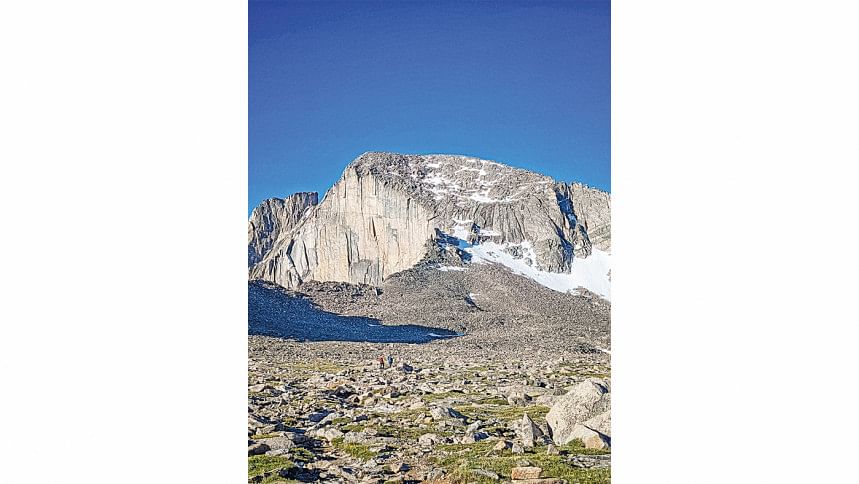
And in the midst of all of these, I slipped from that wall…
A mountain with an altitude of 14,000 feet or around 4,300 meters is not that impressive if you compare it with the Himalayas. But here in the States, it is a pretty big thing.
There's not even a single summit in the USA (excluding Alaska) that reaches the height of 15,000 feet. Naturally, the excitement about these mountains among the hikers is super crazy.
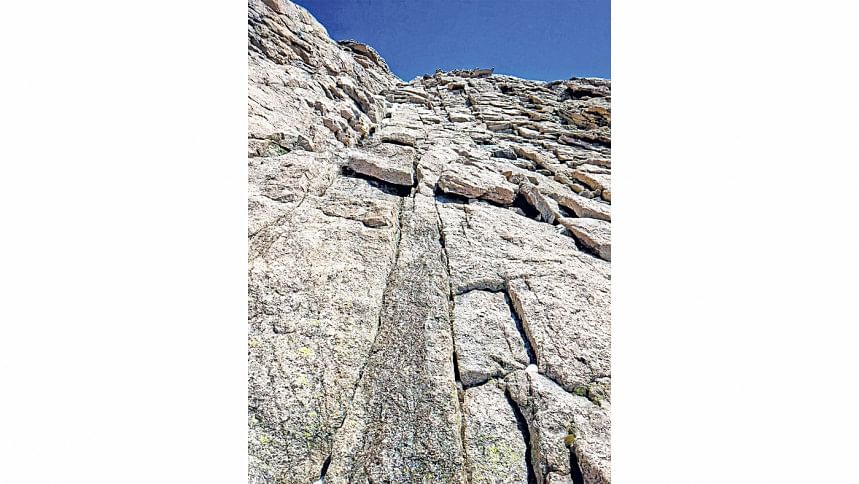
It's kind of justified too. Unlike a trek or climb of similar altitude in the Himalayas, you can't find a village along the trail; you can't even camp in many of these mountains because of the over-complicated rules and permit systems. You can't find a porter or a cook to help you with your loads even if you are ready to pay a good sum! You are completely on your own once you start your trek, which makes scaling these mountains comparatively more daunting a task.
Moreover, a very long summit push with a lofty elevation gain is very common. For example, our summit push for Longs Peak was 12km one way with an elevation gain of around 5,000 feet, which would probably be done in 2-3 days on a standard Himalayan trek of the same altitude. No wonder climbing such a fourteener, a mountain that is at least 14,000 feet high, is considered somewhat of an achievement within the trekking community.
So, out of sheer necessity, Alpinism is practised in the right way here.
With the great Rocky Mountains as its spine, Colorado is truly a paradise to any wannabe mountaineer. Not only does the state have stunning mountainous landscapes, but it alone also has more than half of the highest mountains in the continental US.
Those attractions drew us to Colorado, from Tennessee, which was a 22-hour drive. We planned a week of expedition eying to scale three of the fourteeners.
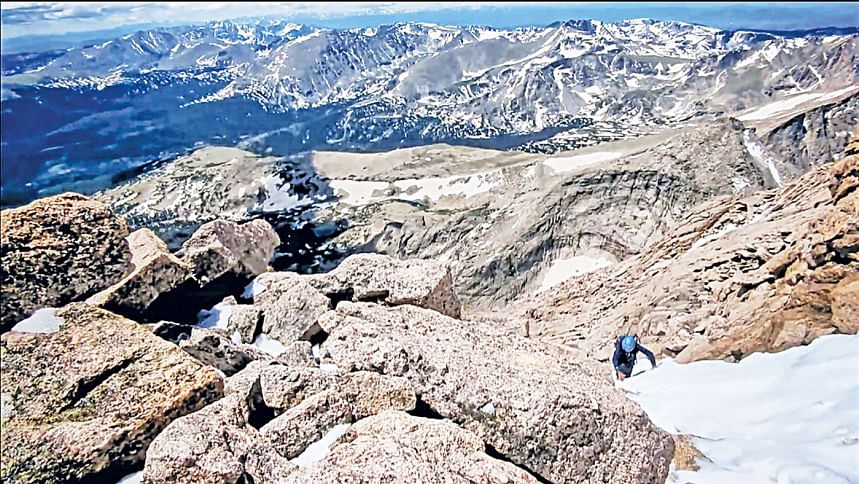
Miraculously, after sliding just 15-20 feet, I managed to grab onto a rock edge preventing my name from being among the victims of this majestic mountain. Cuts on both of my hands were the only price I had to pay.
Longs Peak is considered the most iconic mountain in Colorado. It is also the mountain with the highest death toll. At least 374 trekkers and climbers have lost their lives trying to scale this mountain. The iconic and notorious Diamond Face of it is responsible for most of the deaths.
We chose Longs Peak, the hardest among the three, first to save us from some extra 7 hours of driving. Coming from almost sea level, an acclimatisation day before the actual summit push was planned. We decided to trek to a nearby alpine lake named "Sky Pond" so that we could hike up to an elevation of around 12,000 feet and then come back to sleep at our campsite at a lower elevation of 9,000 feet.
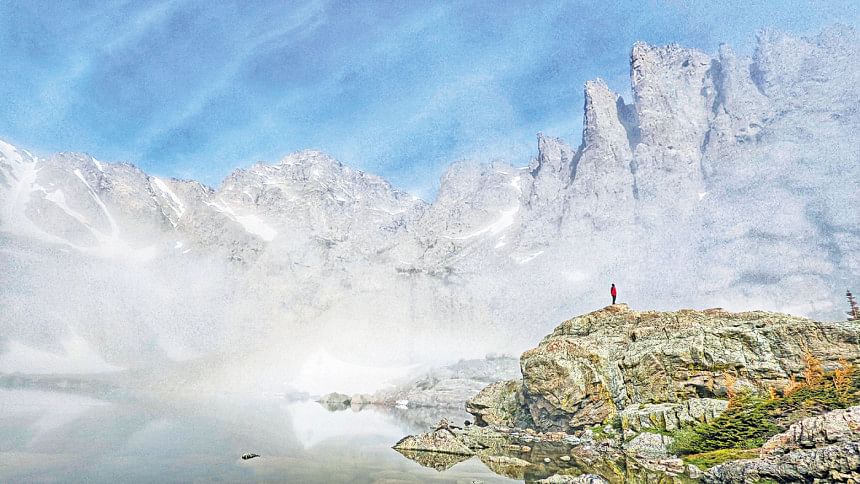
That day was extremely gloomy; the stunning view of the infamous lake with the Sharks Tooth ridge in the background on a day full of whiteouts and hailstorms was the only bliss!
We started our summit push for the Longs a couple of hours after midnight. Afternoon thunderstorms often start from around noon almost every day in the alpine Colorado and death by lightning is not very uncommon. So climbing anywhere above the tree line after midday becomes an extremely risky business. We planned to reach the base of the mountain around sunrise and then climb to the summit in a couple of hours so that we could descend well below the tree line before noon.
But we were dangerously running behind the time.
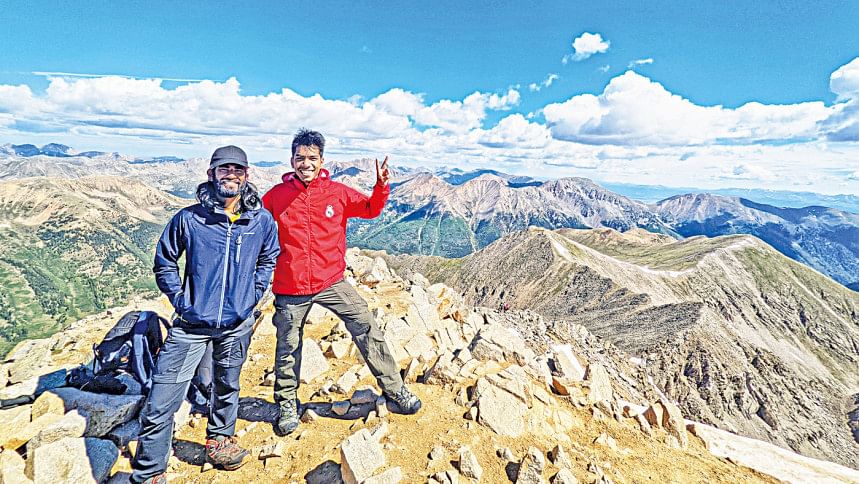
Not sure whether it was the lack of acclimatisation for my Covid-affected lungs or the sprained ankle from the last backpacking trip to Virginia that slowed us down. When we reached the boulder field at the base of Longs Peak, we had only two hours to summit and climb down, which seemed unlikely.
But the weather looked perfect. The bright sunlight was flooding down the clear blue sky and there was not a single trace of any threatening cloud!
In these circumstances, we decided to move ahead. We would go up as much as possible but with the slightest change in the weather, we would stop our push and come back to safety.
After the keyhole - an extraordinarily beautiful carved rock after the boulder field, there were four more regions. "The Narrows" and 'The Ledges" were less challenging. It was "The Trough" where things began to get complicated.
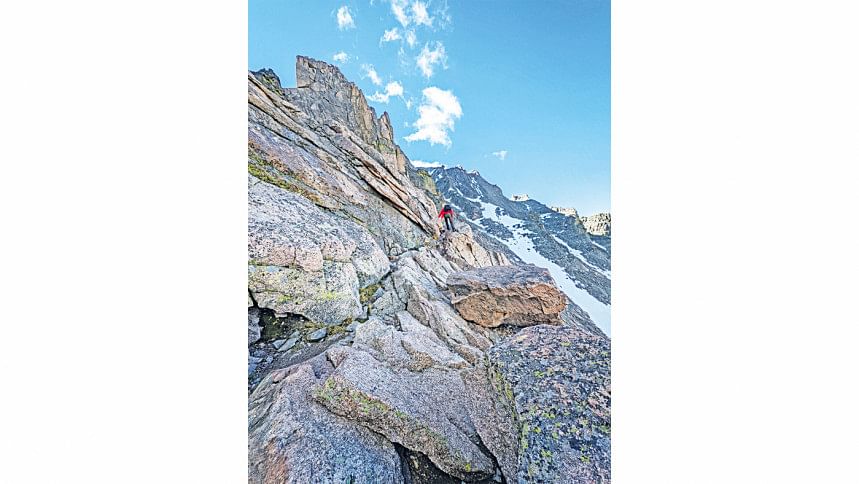
The mountain was in its worst icy condition – neither the snow was as deep and hard as it would be in the winter/spring nor was it melted completely. Almost every rock there was covered with layers of thin ice making the climb way harder. The crampons could not bite the snow properly without breaking the ice.
In some places, we had to move ahead creating our own way, avoiding the standard route. Ultimately, after more than one and a half hours and crossing these three sections, we came to the Homestretch.
Just about 200 feet between us and the summit!

However, the excitement was short-lived. The weather suddenly worsened. The blue sky was darkening fast, a thunderstorm was looming.
Sabbir and I had a small debate at that point about whether we should go ahead ignoring the risk or should we forfeit the summit push despite being so close! Though the Homestretch is only 200 feet in height, it is almost 90⁰. One needs to be extra careful here. After a brief argument, we agreed to take the risk.
Lots of thoughts were in my mind – the time, the threatening clouds, the difficult descent ahead. And that momentary lack of concentration almost proved to be fatal!
I was trying to climb faster than usual and had that fall, losing my foothold. At that moment of weightlessness, an inexpressible chill ran through my spine knowing that at least 30 feet of fall on solid granite would shatter my body.
Miraculously, after sliding just 15-20 feet, I managed to grab onto a rock edge preventing my name from being among the victims of this majestic mountain. Cuts on both of my hands were the only price I had to pay!

It took us another thirty minutes to climb to the top and there was hardly any time for a breather. The dark clouds hovering over our heads now looked more ominous.
There was not another soul on the summit; the last person we met left about half an hour ago postponing his push, from just below the Homestretch. According to him, he was wise enough not to take the risk of being fried by Zeus's bolts!
He also tried to persuade us to go with him. It's a shame we didn't bother.
We could sense the static electricity in the air; even the marmots were afraid, rushing towards any hole they could find for shelter. Though both of us didn't express it that time, deep inside we were scared as hell and had nothing to do except pray for luck.
Fortune again took our side as we found a tiny cave under a boulder in time before nature unleashed a severe hailstorm with intense thunder and lightning.
We remained trapped inside that cave for almost two hours until the storm ended. And finally, when we were back at the trailhead, a total of 17 hours had passed!
After Long's, we summited two more fourteeners on the trip -- Mt Elbert, the highest peak of Colorado and the second highest in the continental US and Huron Peak. Though easier compared to Long's, they were spectacular, especially Huron. With its insanely beautiful alpine meadows and the magnificent 360⁰ view of the whole Swatch Range, Huron was a treat to the eyes. Traversing its long, exposed ridgeline amid intense wind gusts was fun too!
Though nothing much happened in those mountains to tell, we needed that pleasing beauty and peace after such a day in the Longs. We returned home after passing just a week there, but the memories of the mountains of Colorado are still super fresh and alive; as they will be, at least until the next adventures we are planning in the mountains of Wyoming.

 For all latest news, follow The Daily Star's Google News channel.
For all latest news, follow The Daily Star's Google News channel. 




Comments